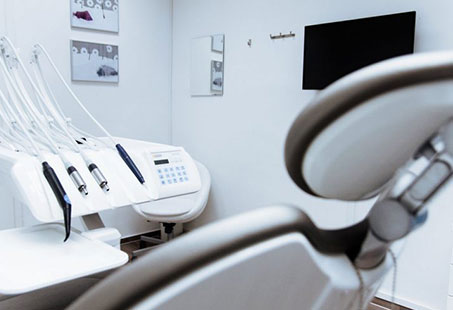Problems in the alignment of the teeth can negatively affect the self-esteem of an individual. Crooked teeth can cause the same problem and even damage the surrounding teeth in case of severe misalignment.
This problem can affect both young and adults, and it is possible for both of them to seek treatment at their ages. It’s rare for them to straighten out on their own, so you’d need orthodontic or cosmetic treatment.
What Are Crooked Teeth?
Normally, the teeth in the upper jaw sit slightly in front of the lower jaw.
However, when the teeth in the upper or lower jaw sit abnormally in front of each other, the teeth are misaligned or crooked.
It can affect both the upper and lower jaw at the same time, and your teeth may appear crowded.
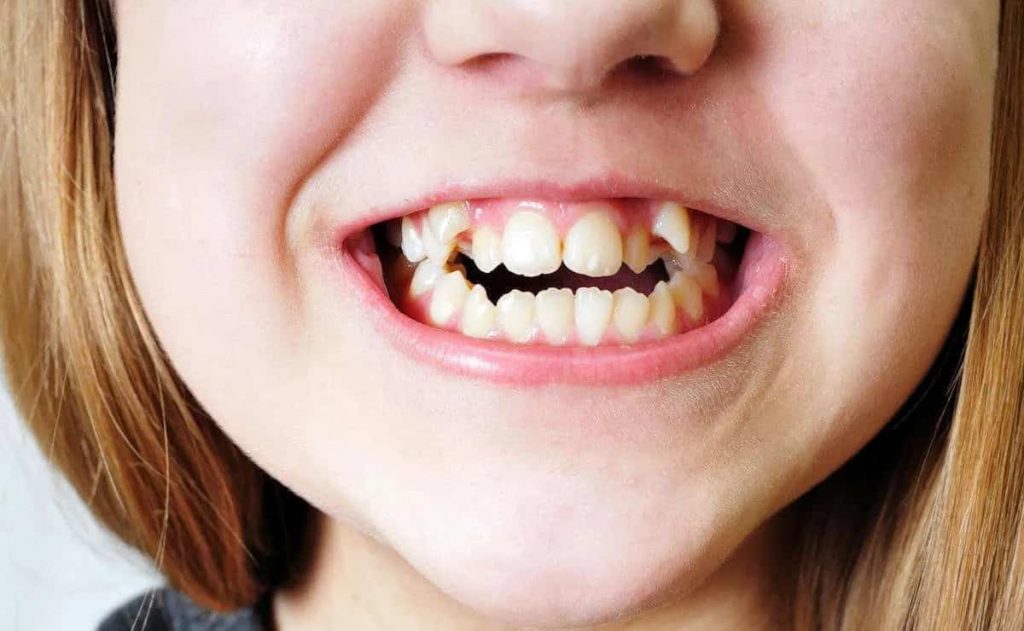
It is possible for the deciduous teeth or milk teeth to come out crooked but straighten out later on. However, you may simply be born with them or develop crooked teeth later in life, after the permanent teeth have erupted.
This condition can only affect one tooth or several of them. While there’s nothing wrong with having crooked teeth, they can cause oral health problems.
This can end up requiring extensive dental work. But your dentist can best tell you if your crooked teeth are problematic.
Crooked Bottom Teeth
It’s possible for you to have teeth that are only crooked in the lower jaw. This is even when the teeth in your upper jaw are well-aligned. However, you can get it fixed through different orthodontic or cosmetic dental treatments.
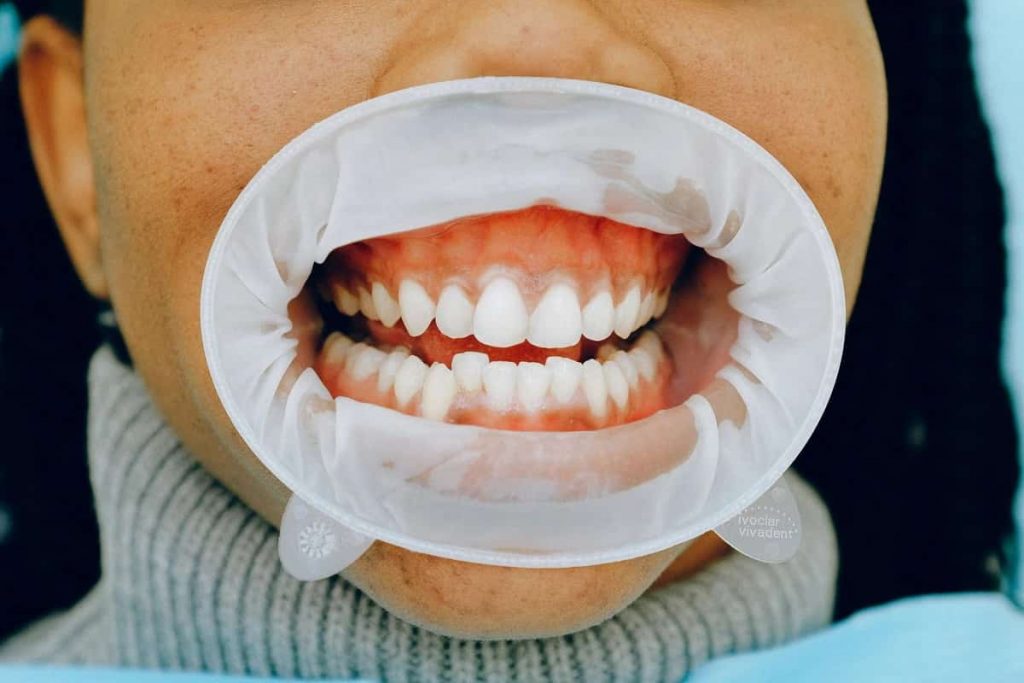
Crooked Front Teeth
In some cases, it’s possible for only the front teeth to be crooked. However, according to StatPearls, when the upper front teeth are crooked in a way that they stick out, it can make them more vulnerable to injuries. Fortunately, orthodontic and cosmetic treatments can fix that as well.
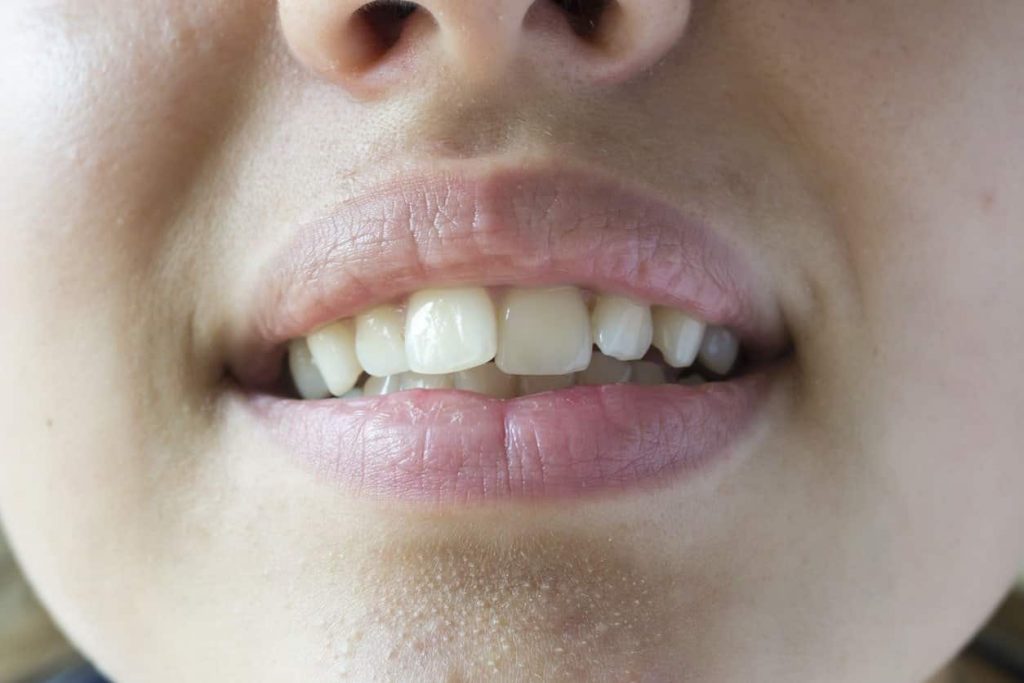
Is Having Crooked Teeth Bad?
The cultural perception of crooked teeth is variable. In Japan, “double tooth” or “yaeba” is considered to be attractive, where the canines in the upper jaw are either protruding from the gums or overlapping another tooth.
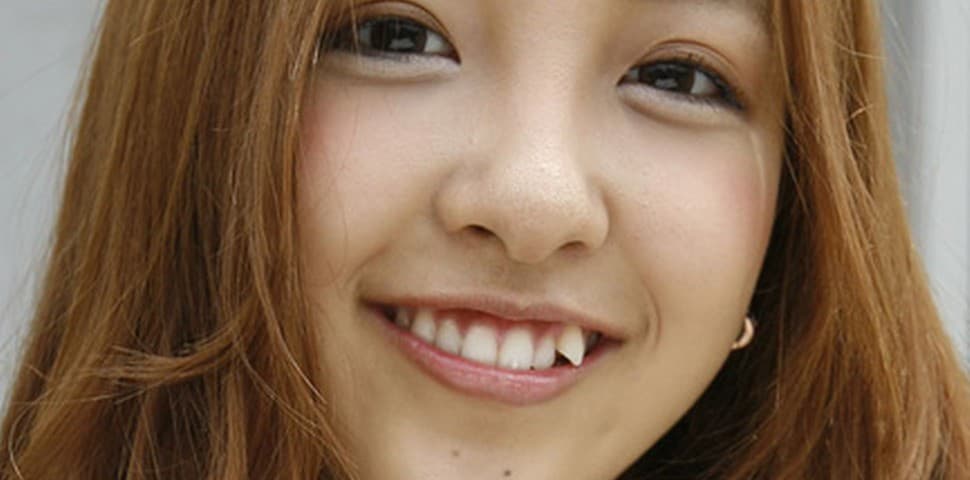
However, not everyone is comfortable with the presence of crooked teeth or finds them attractive.
Other than causing cosmetic problems, crooked teeth can more problematically cause serious oral health problems, such as the following.
Plaque Formation
The problem with crooked teeth is that they’re not easy to clean because of the way they’re positioned. They can also make it difficult to clean the surrounding teeth.
This can result in plaque formation. If the plaque is not cleaned, the acids released by the bacteria can cause cavities.
Eventually, the plaque will harden into what’s known as tartar, which can cause inflammation of the gums and severe gum infection.
Prone To Injury
Because of the protrusion of the crooked teeth, they are more exposed and less protected, which makes them more susceptible to injuries. It is also common for these teeth to experience more wear and tear and chipping.
Bad Bite
Since crooked teeth are a type of malocclusion, they can cause problems with the bite.
And a bad bite can cause other problems like temporomandibular joint (TMJ) disorders, chewing and speech difficulties, and headaches.
Also, teeth grinding is a common problem in people who have a bad bite because of the way that the teeth meet with each other. It worsens the condition of the teeth.
Sleep Apnea
It is a sleep disorder in which the breathing is abnormally interrupted while the person is sleeping.
And according to a study published in Internal Medicine, malocclusion can play a role in the development of this disorder.
What Causes Crooked Teeth?
Different factors lead to crooked teeth, and not all of them are under our control.
Evolution
Research has shown that our ancestors did not suffer from malocclusion. They had enough room in their mouth to accommodate all the teeth comfortably.
That’s because of the kind of food they consumed and their jaw size. However, over time, the size of our jaws has shrunk.
Our diet is not the same as the hunters and gatherers. We consume softer, processed foods that require less chewing.
However, the shrinking of jaws meant that the teeth didn’t have enough room to fit in normally, in many cases. Hence, the problems of crowding and crookedness.
Stanford researchers also give another reason for this shrinking – our “oral posture.” The bones in our mouth aren’t getting the pressure they need to shape normally, because we sleep on softer surfaces that have our mouths open.
Therefore, industrialisation and human evolution have increased the incidence of this problem.
Genetics
The shape and size of the teeth and the jaw are largely determined by your genes. So, that means if people in your family have crooked teeth, you are also likely to end up with them.
Parafunctional Oral Habits
One of the more common causes of malocclusion is poor oral habits. This includes sucking your thumb or any other fingers. Sucking your lips or pieces of cloth like a blanket is also included in this.
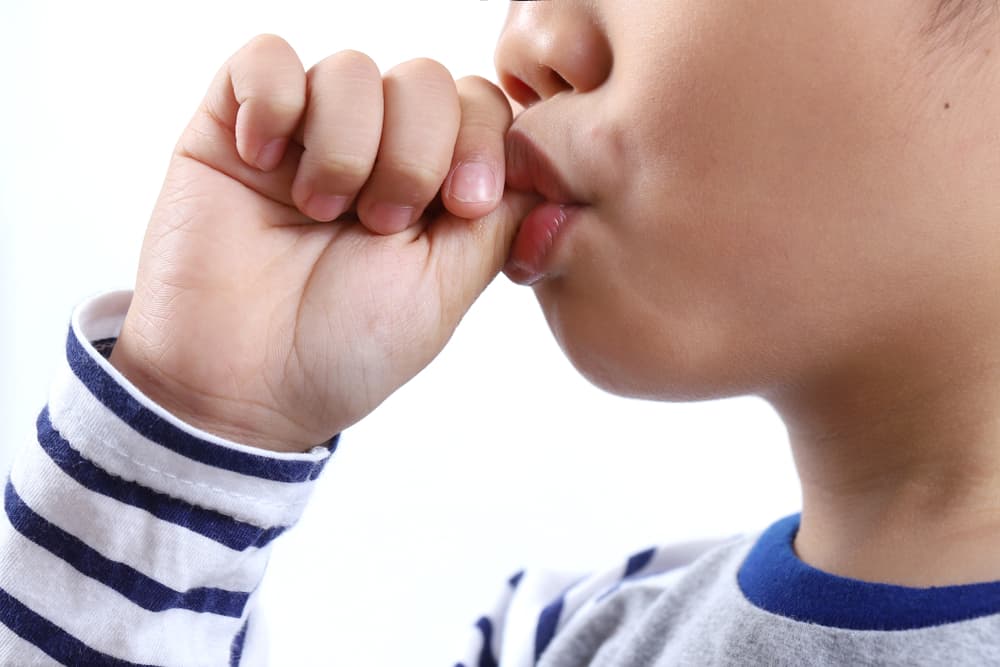
Moreover, prolonged use of suckers/pacifiers and bottle-feeding can end up causing crooked teeth. That’s why it’s recommended that the use of bottles and pacifiers should not be continued after the age of three.
Other poor oral habits include thrusting the tongue. Children can do this when they’re swallowing and speaking. Therapy may be needed for this. Among some other poor oral habits are mouth breathing and biting your nails.
Birth Defects
Children who’re born with a cleft palate or cleft lip can experience teeth problems, which include crookedness around the cleft.
It can happen because either the teeth are missing in the cleft area or have malformations. It is also possible that there is an extra tooth there.
Physical Trauma
Following a significant physical trauma, you can end up with crooked teeth even if you didn’t have them before. The teeth can shift as your body is healing.
The loss of single or multiple teeth can also cause the remaining to move into the empty space left behind. This is why it’s recommended to get dental restorations like implants so that the remaining teeth stay in place.
Poor Oral Health
If you don’t take good care of your teeth, you’re likely to end up with tooth and gum problems. In the case of gum infection, the hold of the gum tissue on the teeth is loosened so they can move.
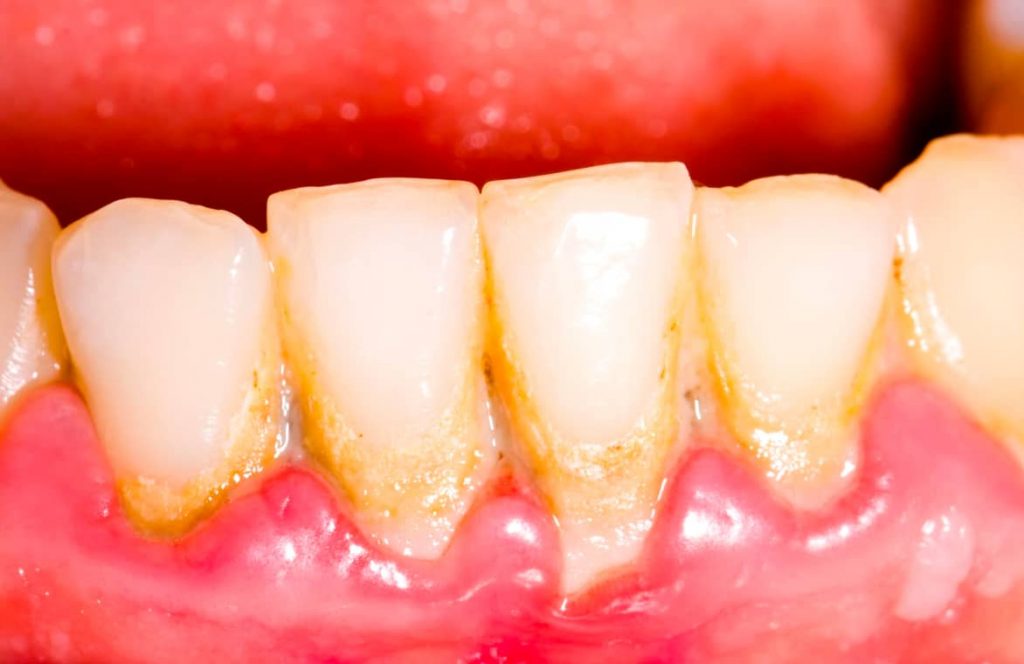
It is one of the symptoms of gum disease. However, this teeth shifting can also result in crookedness.
Other Causes
There are also some other reasons why a person may end up with crooked teeth, and these are as follows:
- Oral tumour
- Extra teeth
- Missing teeth
- Premature tooth loss
- Unusually shaped teeth
- Improperly fitted dental appliances
How To Fix Crooked Teeth?
Your dentist may recommend the following crooked teeth treatments:
Braces On Crooked Teeth
Traditionally, metal braces are recommended for fixing teeth misalignment. They’re also considered the best treatment for crooked teeth.
The dentist will place brackets on the teeth, which are connected together through a metallic wire.
This wire is adjusted/tightened to push the teeth into the desired shape.
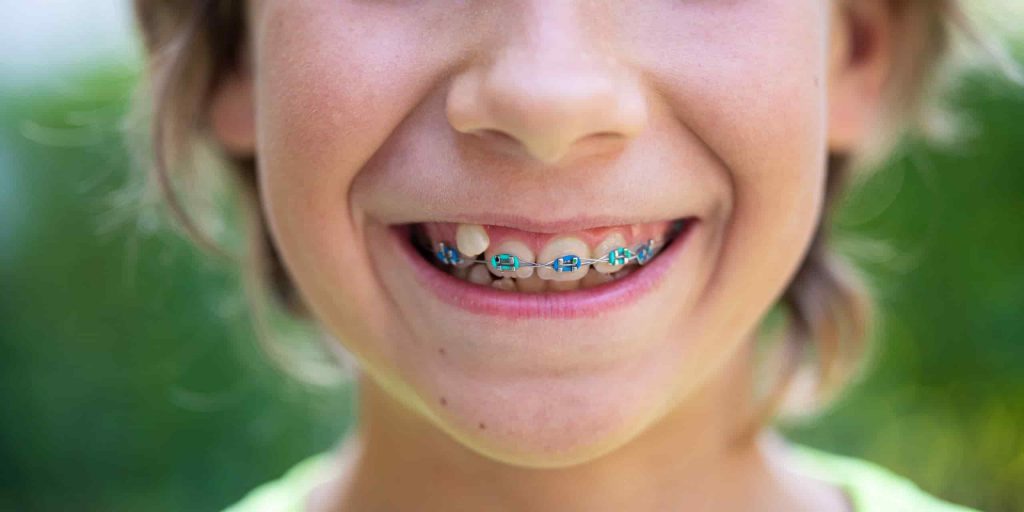
This treatment usually takes 1-2 years, and it’s not always easy. Many people experience pain and discomfort for a few weeks after getting braces.
They also cannot eat hard, sticky foods like nuts and caramel. Still, braces on crooked teeth are quite effective in aligning teeth.
Clean Aligners
For less severe cases, it is also possible to fix the problem with the help of clear aligners. Invisalign is the most popular one.
Some people prefer it over wearing braces because they are, well, “invisible,” but they are not effective against severe cases of misalignment.
You will have to wear these at all times, except when you’re eating or brushing your teeth. In addition, a new Invisalign aligner tray would be needed after every 2-3 weeks as the teeth change their position.
Retainers
Retainers are removable dental appliances that are custom-made to fix crooked teeth. They work the same way as clear aligners, and you can take them off when you’re eating or brushing your teeth.
Keep in mind that certain oral habits can scrape the metal of the retainers against the teeth, which can damage the enamel.
Composite Bonding For Crooked Teeth
If you’re wondering how to fix crooked teeth without braces, composite bonding can help. But it works best when the teeth are just slightly crooked.
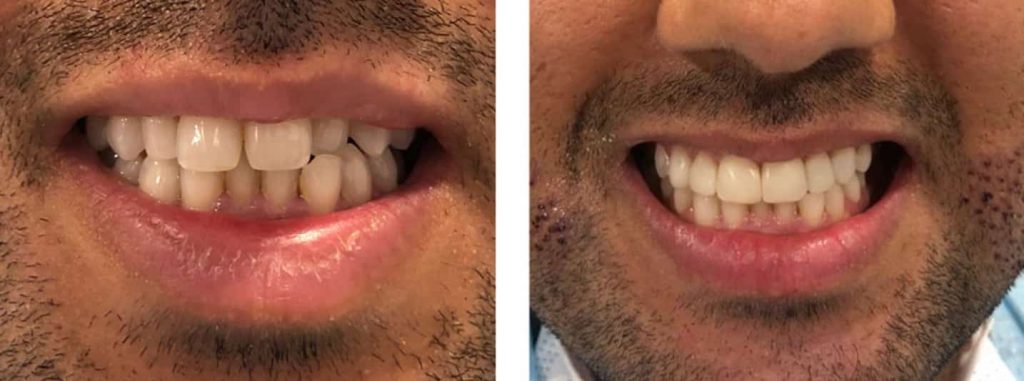
Composite bonding is a minimally invasive treatment in which your dentist will mould a composite resin putty on your teeth. There’s no need to shave the teeth beforehand.
So, the answer to whether can you get composite bonding on crooked teeth is yes, but the misalignment shouldn’t be too severe. Otherwise, the results won’t be satisfactory.
Veneers For Crooked Teeth
Dental veneers are wafer-thin shells that are placed on the front surface of the teeth. They can also help correct minor crookedness.
In order to place them, the dentist will first prep the teeth by shaving the enamel by a few millimetres. This is done so that the veneers do not look bulky.

So, the answer to can you get veneers with crooked teeth is also yes.
Crowns
Dental crowns are another type of restoration that can fix crooked teeth. Since they require more extensive tooth prepping, the teeth can be more easily reshaped.
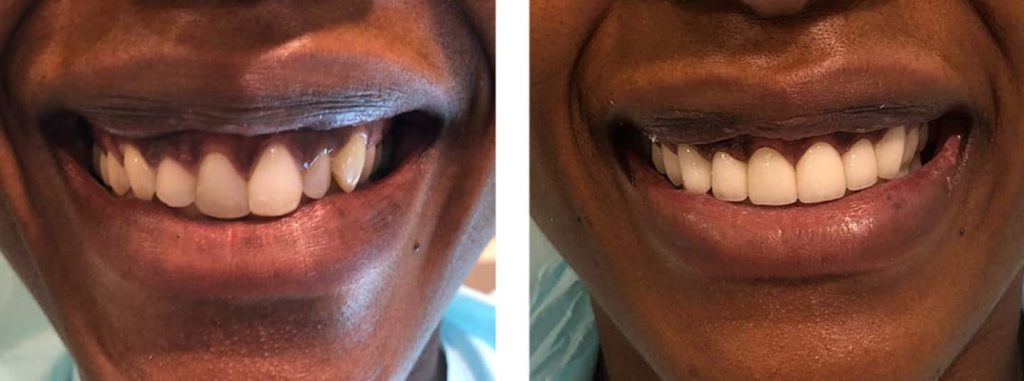
However, you may not always be suitable for this treatment option, especially if the problem is only minor.
Palate Expanders
As mentioned above, crooked teeth can develop due to problems with the size of the jaw. If it’s too small compared to the size of the teeth, they’re going to end up crowded and crooked.
A palate expander is a dental device placed against the roof of the mouth and fixed to the back teeth. A key is turned to adjust the pressure that it applies to the jaw.
Can You Fix Crooked Teeth Through DIY?
The Australian Dental Association has warned against the practice of buying online “do-it-yourself” dental kits.
People themselves take the impression of their teeth to later get an orthodontic appliance mailed to them. The process does not involve any dentists or medical professionals.
This practice can end up causing permanent damage to the teeth, jaws and gums. You can end up worsening your oral health condition.
It is also possible in this case that the treatment plan is flawed, which will result in reversals of any positive results.
How Long Does It Take To Fix Crooked Teeth?
It depends on the kind of treatment you’re getting. Crowns and veneers give immediate results in a matter of days. However, it can take anywhere between 2-3 years, maybe even more with braces, aligners and retainers.
It’s best to start the treatment at an early age. These kinds of problems become evident between the ages of 6 and 12. However, orthodontic treatments can also be the answer to how to fix crooked teeth in adults.
Keep in mind that as you get older, the changes in the density of the jawbone cause the teeth to shift and come together. This can also cause crookedness.
Conclusion
Crooked teeth are a type of malocclusion that’s sometimes inevitable. However, it can also be prevented in some cases, where the problem is poor oral habits or hygiene.
Keep in mind that you can get treatment for it at different ages. How long it lasts will depend on the severity of the problem and the treatment itself.
It’s important that you get yourself checked by a dentist.
Are crooked teeth genetic?
Crooked teeth can be caused by genetics. If the people in your family have crooked teeth, you might have too.
How to fix crooked teeth without braces?
Instead of getting braces, you can fix crooked teeth without them using clear aligners, retainers, composite bonding, veneers, crowns, or palate expanders.
Can you get veneers with crooked teeth?
You can get veneers with crooked teeth. In fact, veneers can help straighten your crooked teeth by reshaping them.
Can you get composite bonding on crooked teeth?
Composite bonding can help with slightly crooked teeth to improve the overall appearance of your smile.
Can crooked teeth cause a lisp?
Malocclusion caused by crooked teeth can cause speech problems like a lisp.
Can crooked teeth cause bad breath?
If you’re unable to clean your teeth properly because of crookedness and end up developing gum disease, it can cause bad breath.
Can crooked teeth cause gum recession?
If you’re unable to keep your teeth free of plaque due to crookedness, it can cause gum disease and gum recession.
